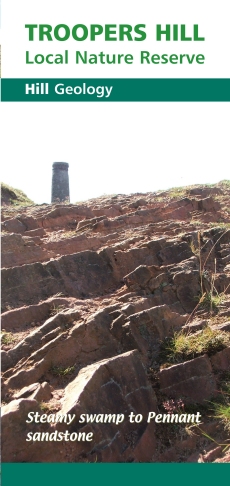|
- Home
- Work Parties
- Events
- Newsletters
- Meetings
- Funds
- News & Views
- Contact
- Young Friends
- Nature in the City
- Friends' Friends
- Video Project
- Photo Survey
- LNR
- The Field
- The Woods
- Management Plan
- Wildlife
- Geology
- History
- Memories
- Old Photographs
- Visitors Photos
- Information

© Common Lizard
by Abi Stubbs
|

|
|
Troopers Hillís geology is unusual in Bristol. Much of the city lies on Carboniferous Limestone, but Troopers Hill is dominated by sandstone of the Pennant Measures which are sedimentary rocks formed in tropical swamps some 300 million years ago. In places, the sandstone can be seen on the surface, both as natural outcrops and old quarry faces.
The combination of sandstone and local industry has resulted in acid soils, which are rare in Bristol. This has encouraged a wealth of plants to flourish, that are found nowhere else in the City.
Much of the shape of the hill is the result of quarrying for the sandstone which was used as building stone throughout Bristol. The largest quarry was the gully in the centre of the hill which was worked until the end of the nineteenth centuary. The humps and bumps above Troopers Hill Rd are where the unsuitable stone was tipped.
As well as sandstones the Pennant Measures include mudstones, shales, clay and coal seams. In the past coal has been dug where it outcroped on the hill and both fireclay and coal have been taken from deep mines under the hill.
More information is available in our 'Hill Geology' Leaflet which is available via the link below.
 Download Site Leaflets Download Site Leaflets
|
 |
GeomorphologyThe rock face at the end of the gully clearly shows how the layers of rock have been tilted due to various movements in the earths crust during the hill's 300 million year history. Geomorphology is the science concerned with understanding the form of the Earth's land surface and the processes by which it is shaped, both at the present day as well as in the past. British geomorphologists are involved in research into the processes of weathering and erosion, sediment transport and deposition, the characterisation of landforms and the materials of which they are composed.
You can learn more about geomorphology at www.geomorphology.org.uk and about Geology at the British Geological Survey website.
|
|

|
|

